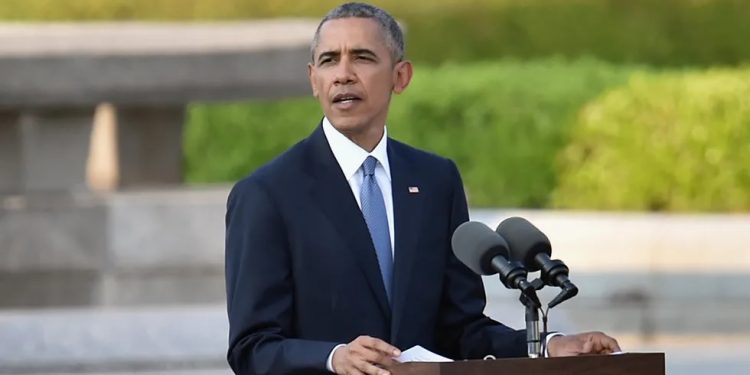A newly declassified document has made it easier than ever to see how the media and political figures worked hand-in-hand to mislead the public and manipulate the political narrative.
The House Permanent Select Committee on Intelligence (HPSCI), along with Director of National Intelligence Tulsi Gabbard, has released a 2020 Oversight Investigation and Referral report examining the 2016 Intelligence Community Assessment (ICA) titled “Russia’s Influence Campaign Targeting the 2016 US Presidential Election.”
The report reveals that under former President Barack Obama’s direction, then-CIA Director John Brennan and select intelligence officials rapidly assembled the ICA just weeks after Hillary Clinton’s 2016 loss. This ICA became the basis for the now-debunked Russia collusion narrative — the allegation that Trump and Russia conspired to steal the election.
However, the ICA itself was flawed, having been produced hastily with questionable sources. These included the discredited Steele dossier and a six-word phrase taken out of context that vaguely referenced Trump. The report indicates that intelligence officials warned Brennan against using unreliable, biased, and unclear material. He disregarded them.
According to Federalist Editor-in-Chief Mollie Hemingway and Senior Legal Correspondent Margot Cleveland, senior intelligence officers strongly objected to including the Steele dossier in the ICA — objections Brennan ignored. Obama and major media outlets later presented the ICA as definitive evidence of collusion.
Now, with the HPSCI report publicly available, revisiting the original media coverage exposes the extent of falsehoods used to promote the Russia hoax. The New York Times and Washington Post have not issued corrections; instead, they continue defending the original claims.
The New York Times Then
The Times played a major role in advancing the collusion narrative. A January 2017 piece by David Sanger repeated claims now shown to be unfounded:
“American intelligence officials have concluded that the president of Russia, Vladimir V. Putin, personally ‘ordered an influence campaign in 2016 aimed at the U.S. presidential election,’ and turned from seeking to ‘denigrate’ Hillary Clinton to developing ‘a clear preference for President-elect Trump. The conclusions were part of a declassified intelligence report, ordered by President Obama,’” the article stated.
That report, the ICA ordered by Obama, has now been shown to be politically motivated and lacking credibility. Contrary to its claims, the newly released findings suggest Russia was indifferent to the election outcome but had logical reasons to prefer Clinton.
Nonetheless, the Times and the Washington Post were jointly awarded a Pulitzer Prize in 2018 for their Russia collusion coverage — a prize some now argue rewarded propaganda rather than journalism.
The New York Times Now
Today, the Times continues defending the Russia hoax. A recent article claimed that “none of the new information changes the fundamental view that Russia meddled in the election and that Mr. Putin hoped to damage Hillary Clinton, the Democratic nominee.”
In a separate article titled “Gabbard Claims Obama Administration Tried to Undermine Trump in 2016,” the Times reported that Democrats dismissed the new findings as “politically motivated and error-ridden.”
Yet on July 2, the Times had published a piece titled “C.I.A. Says Its Leaders Rushed Report on Russia Interference in 2016,” acknowledging the ICA had flaws. Still, it insisted Russia favored Trump.
Citing unnamed former officials, the article claimed the Steele dossier “was not used in drawing conclusions of the assessment and that Mr. Brennan was opposed to its inclusion [in the ICA].” But the newly released report contradicts that — stating Brennan pushed for the dossier’s inclusion to bolster the collusion claims.
The Washington Post Then
The Washington Post, which also received a Pulitzer for its coverage, ran numerous stories pushing the hoax, including a dramatic 11-minute video in June 2017. The video used the ICA to suggest Russian interference was a settled fact. It described a supposed delivery of “highly classified material” to Obama and his top aides, citing Brennan’s report as near-conclusive evidence that Russia sought to help Trump.
Greg Miller, a Post national security reporter, narrated that “The CIA director was convinced that this was as close to smoking gun evidence that the CIA ever gets.”
Yet the video never showed the report, never confirmed how the Post learned about it, and offered no indication that any reporter actually saw it. Viewers were expected to accept the narrative without proof.
The Washington Post Now
After the release of documents discrediting the Post’s Pulitzer-winning work, the outlet quickly responded with more coverage, attempting to discredit Gabbard and Trump. One piece, titled “Gabbard uses surprise White House appearance to attack Trump’s enemies on the Russia investigation,” claimed Gabbard was “escalating her attempts to undermine the long-settled conclusion that Russia tried to help Trump beat Hillary Clinton.”
Written by David Klepper, Eric Tucker, and Chris Megerian, the article was circulated by the Associated Press and reproduced widely, spreading the same disputed narrative.
Within hours, the Post published several more articles with similar messaging — continuing to defend its previous reporting and discredit those challenging it, particularly Gabbard and the information that now contradicts its original narrative.
Beth Brelje is an elections correspondent for The Federalist and an award-winning investigative journalist with decades of media experience.
 Telegram is where we really talk. Don't miss out!
Telegram is where we really talk. Don't miss out!








